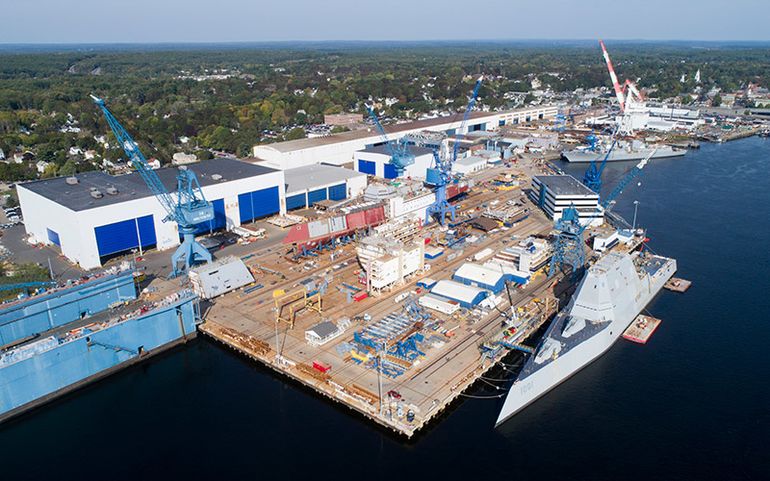
A group of bipartisan lawmakers have drafted legislation aimed at recapitalizing America’s public and private shipyards, as Congress and the Biden administration grapple with a nationwide infrastructure improvement plan.
The Supplying Help to Infrastructure in Ports, Yards, and America’s Repair Docks (SHIPYARD) Act, unveiled Wednesday, would use the Defense Production Act to give the Navy the $21 billion it’s seeking to recapitalize its four public yards. The service would have 20 years to use the funds, a Senate aide told USNI News. This would provide the Navy more leeway than if it received the funding in annual appropriations bills.
Sen. Roger Wicker (R-Miss.) is leading the legislative effort. The bill is written to fulfill the Navy’s Shipyard Infrastructure Optimization Plan (SIOP) initiative that calls for $21 billion over the course of 20 years to upgrade the four public yards.
“The SHIPYARD Act will leverage DPA funding authority to expedite and expand the U.S. industrial base needed to promote national defense. DPA Title III authorities are available to support protection or restoration of critical infrastructure, among other purposes,” a Congressional summary of the legislation reads. “The bill allows a 20-year period to obligate funds to align with SIOP, but all funds will be available upon enactment to give the Navy flexibility and the ability to accelerate improvements.”
The legislation, if passed, would also allot $2 billion for the private construction yards and another $2 billion for the private repair yards. The bill would give the Navy secretary discretion over how those funds were dispersed.
“In addition to the Nation’s public shipyards, the United States continues to rely on the capacity and capabilities of private new construction and repair shipyards to meet the strategic maritime needs of the United States Navy, the United States Coast Guard, and the Nation’s maritime industry,” the text of the legislation reads. “Such shipyards, located on every coast of the United States, also require substantial recapitalization and reconfiguration in order to meet the construction and sustainment requirements of our maritime Nation.”
The idea is that Congress could wrap the SHIPYARD Act into a larger infrastructure package, the Senate aide said.
Five senators – Wicker, Sens. Jeanne Shaheen (D-N.H.), Tim Kaine (D-Va.), Angus King (I-Maine) and Susan Collins (R-Maine) – have signed onto the bill. All the senators hail from a state that includes either a public or private shipyard.
“As lawmakers consider ways to improve our nation’s infrastructure, the facilities that support our Navy fleet should be a part of the conversation,” Wicker, who previously chaired the Senate Armed Services seapower subcommittee, said in a news release. “Congress has already taken the important step of committing to a larger Navy, but our shipyards are having trouble servicing today’s 296-ship fleet, and are clearly insufficient to maintain the 355-ship or larger fleet we need to counter China, Russia, and other adversaries.”

Reps. Mike Gallagher (R-Wis.) and Rob Wittman (R-Va.) – the vice ranking member of the House Armed Services Committee and the ranking member of the HASC seapower and projection forces subcommittee – also signed onto the bill.
The legislation defines a private construction yard as one that is building a ship for the Navy in accordance with its latest 30-year shipbuilding proposal and a private repair yard as “any shipyard that performs or is planned to perform maintenance or modernization work on a combatant or support vessel included in” the latest shipbuilding plan.
King, whose state includes both Bath Iron Works and the Navy’s Portsmouth Naval Shipyard, in a statement argued that increasing the size of the fleet means the service must upgrade the yards.
“As the Navy seeks to grow its fleet to address an array of challenges across the globe, and the associated maintenance requirements continue to expand, it is absolutely essential that we provide these shipyards with the modern tools and technologies they need to meet growing demand,” King said in the news release. “This bipartisan legislation will make much-needed investments in a critical part of our national security infrastructure – including adaptations to prepare for the potential impacts of climate change – ensuring that these storied yards will be able to continue to fulfill their important duties for decades to come.”
The SHIPYARD bill comes as the Biden administration toggles with lawmakers over an infrastructure push. While President Biden in late March announced a $2.3 trillion infrastructure proposal, Republican lawmakers last week issued a $568 billion infrastructure blueprint of their own. Wicker, who is the ranking member of the Senate Commerce Committee, was one of the Republican senators to release last week’s GOP proposal.
Wittman has for months argued that the Navy’s 20-year timeline for the SIOP is too lengthy, even suggesting the service cut the plan in half to ten years. Several House lawmakers have either expressed concerns that the service’s 20-year time horizon is too long or argued the Navy should fast-track the timeline.
During a House Armed Services Committee last month, Naval Sea Systems Command Chief Vice Adm. Bill Galinis told lawmakers he directed his staff to assess shorter timelines for the SIOP, USNI News previously reported.





